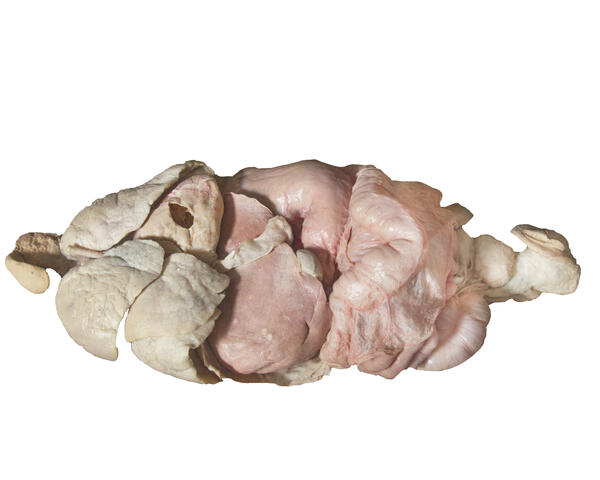‘The Anatomical Theater’ hall of the Military Medical Museum houses a collection of anatomical specimens. Its central exhibit is a complex of human body organs specimens — internal human organs extracted from a human body from the tongue to the rectum. The complex was made in the technique of polymer preservation, or plastination, by specialists from the Department of General Anatomy under the Military Medical Academy. The group of experts was headed by the developer of the method — Professor Ivan Gayvoronsky.
The purpose of plastination is to replace the liquid and fat of the human body with a neutral polymer, while maintaining the shape of body organs. An anatomical object made using this technique is called a plastinate. Such exhibits can be stored for a very long time.
In the middle of the 20th century, the chemistry of high-molecular compounds began to actively develop at the time, scientists obtained a wide range of stable polymers. Anatomists began to use polymers — they injected substances into blood vessels and hollow structures of human body organs in order to obtain high-quality casts. At the same time, scientists experimented with the storage duration of human tissues — body organs were coated with different polymers. And in the late 1970s, Gunther von Hagens, an anatomy teacher at the University of Heidelberg, developed and patented a technique for impregnation of human body organs and sections with transparent polymer compositions. This technique was named ‘plastination’.
Since 1994, several original technological processes and polymer compositions for plastination have been patented at the Department of General Anatomy under the St. Petersburg Military Medical Academy. This technology was named polymer preservation.
Compared to traditional wet preparations, plastinates have several advantages. They are non-toxic, unlike formalin-fixed specimens, and they are odorless. Plastinated specimens of human organs retain their natural shape, volume and color. Unlike wet preparations, they can be studied manually, that is, by touch. The storage duration of these specimens is practically unlimited: they are very durable and wear-resistant, and do not require special containers for storage. Not only separate human body organs, but large anatomical regions or a whole body could be plastinated using the technique of polymer preservation.
Complex of human body organs specimens
Время создания
2008
Место создания
Saint-Petersburg
Размер
10x45x21,5 cm
Техника
polymer preservation
Коллекция
3
Открыть в приложении#4
Ivan Gayvoronsky
Complex of human body organs specimens
#2
#3
Ministry of Culture of the Russian Federation
читать дальшескрыть
00:00
00:00
1x
Complex of human body organs specimens
Время создания
2008
Место создания
Saint-Petersburg
Размер
10x45x21,5 cm
Техника
polymer preservation
Коллекция
3
Открыть в приложении
Поделиться



